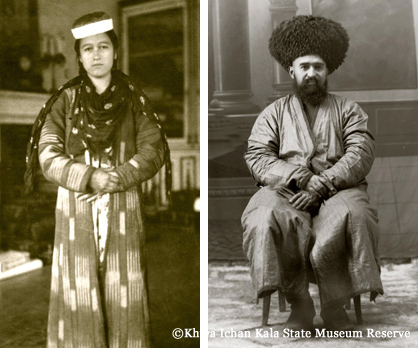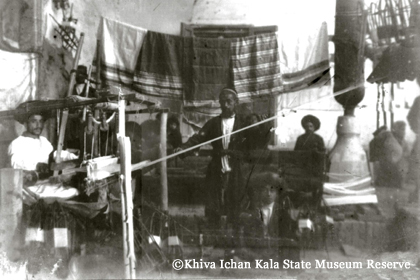 As all the spheres of the life, learning national clothes is related to learning the ethnic history and culture, its communication with other people. It is a factor that expresses the characteristics and ethnic signs among material and cultural heritages of our people. National clothes reflect our customs, social relations, some elements of ideology, religious belief, fineness and ethnic quotas of our people. Apart from these national clothes reflect the season of human’s life, birth place, time, social atmosphere, happiness and sorrow of people.
As all the spheres of the life, learning national clothes is related to learning the ethnic history and culture, its communication with other people. It is a factor that expresses the characteristics and ethnic signs among material and cultural heritages of our people. National clothes reflect our customs, social relations, some elements of ideology, religious belief, fineness and ethnic quotas of our people. Apart from these national clothes reflect the season of human’s life, birth place, time, social atmosphere, happiness and sorrow of people.
The collection of old national clothes reached us from late XIX, early XX centuries, very old ones did not reach until our days because it was much used in everyday life. Style of clothes took the shape depending on the continent. Even though style was similar, fabric and design was different from each other in each region. (some types of clothes that had religious importance passed from generation to generation as a haritage.) National clothes of our people are various, multi-colored and attractive. It was possible to recognize people according to their clothes which social type belong to in all times such as craftsmen’s clothes, farmers’ clothes, local clergies’ clothes and national clothes for different ceremonies of people such as wedding clothes, circumcision boy’s clothes, funeral ceremony clothes, celebration clothes and everyday life clothes. It is also divided according to the gender and different ages.
Cotton reproducing and fiber weaving was much developed in the early XIX century and there were 27 silk fiber, 45 coat (chapan-traditional coat of Uzbek people) sewing, 28 konchi (leather producing), 72 dying, 50 shoe making, and 20 jewelary factories.
Farmers mainly produced cotton and silk fiber as half raw material and sold them to craftsmen. And the craftsmen reproduced as ready fabric such as boz(local cotton fabric), alacha and sold them in the local markets. Dyes played important role in producing the fabrics. They dyed the produced fabric in different colors. The ready fabrics were dyed by the chitkars (fabric dying masters) in different designs and sold them in the markets. And people made different clothes out of those fabric for every dat life.
The masters used chinese silk, Indian and Iran dyes in producing those materials. People not only used the local materials but they, especially the aristocrats bought improted products such as pea-cock designed Chinese, Iran, Russian and Turkesh silk fabrics atlas (silk fiber), adras (silk and cotton fiber), zarbaff (golden fiber), colored kimkhaab (sort of velvet). And aristocrat women especially used Japanese velvet, to make hats, Russian floral designed plotno, surp, chit and Azerbeyjan scarfs.
There were 99 weaving and more than 180 masters worked in the sewing factories in Khiva. Various types of fabrics were imported and traded in the inner markets. For exapmle 5000 winter coat (Uzbek chapan) was prodused in Khiva.
Although nowadays most Uzbeks wear European-style clothes, especially in the cities, some elements of traditional clothing are still incorporated. In the countryside and at national ceremonies you can still see people in traditional dress, and even today, gold-embroidered zarchapan (caftan) and turbans made of gold or silver brocade are indispensable parts of men's wedding garments.
 Weaving is one of the most ancient crafts that was created by human being. Its history dates back to the stone age. The archeologists excavated pieces od woven fabrics from the ancient settlements like Khiva. First people started weaving by hand and over the centuries. And they created a weaving machines so that they could weave more fabrics out of many different fibers such silk, cotton and so on.
We have broader information about weaving from the medieval ages. One can meet these information in the records of travelers, historians and several historical documents that date back to medieval ages.
Each place has its own characteristics of weaving.
Weaving is one of the most ancient crafts that was created by human being. Its history dates back to the stone age. The archeologists excavated pieces od woven fabrics from the ancient settlements like Khiva. First people started weaving by hand and over the centuries. And they created a weaving machines so that they could weave more fabrics out of many different fibers such silk, cotton and so on.
We have broader information about weaving from the medieval ages. One can meet these information in the records of travelers, historians and several historical documents that date back to medieval ages.
Each place has its own characteristics of weaving.
Weaving has many different branches and it is defined depending on which fiber you use and what you weave. In the history of man kind cotton, silk, wool have been much used in weaving. Apart from these people use several trees and plants to produce fiber such as flax, hemp. But silk products were valued very highly and spread all over the world through the Silk Road. The history of weaving is divided into two types: one is for every day use and the second is for sale. Because both settled and nomad tribes produced woven products by themselves to supply naturally.
And for sale Khorezmians produced mainly boz, alacha, shoyi, adras, dukhoba. Boz is a cotton fabric and much used everywhere, especially for low class people, adras, shoyi, dukhoba have higher value and it was used by high class people to sew precious clothes.
There many precious museum exhibitions in the applied art museum of Ichan Kala State Museum Reserve dating back to XVIII-XIX centuries. It proofs that the weaving craft was developed here for thousands of years. And the skill of masters took up to the level art. Khorezmian masters used white, light red, blue, and green colors in weaving fabrics, and they only used natural dyes. They used pechaki, marghula, morpech, qochqarak, murchgul, islimiy like in all decorative art.
People sewed pants, coats, hats, waist bets and women dress, praying carpets and other thing for everyday use. The colors, design meant the class and gender of people in the society in Khorezm. For instance men only used clothes made out of cotton fabric and silver and women silk and gold.
Khorezm appeared one the center of woven products in Central Asia, And it offered it products in the market of Asia and Europe at this time. Especially hand made silk carpets played an important role in the silk product trade in Khorezm.